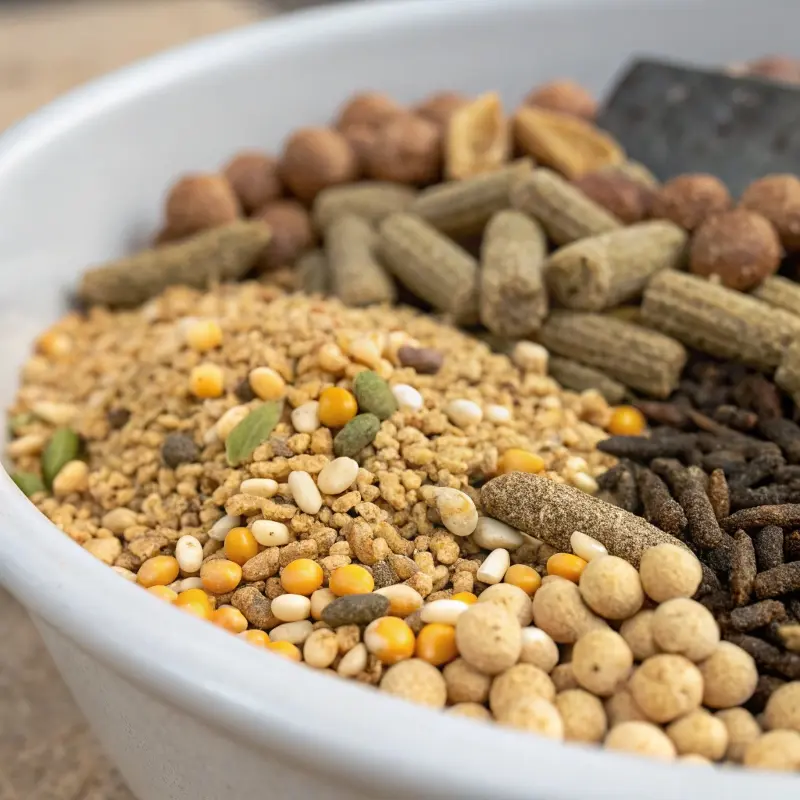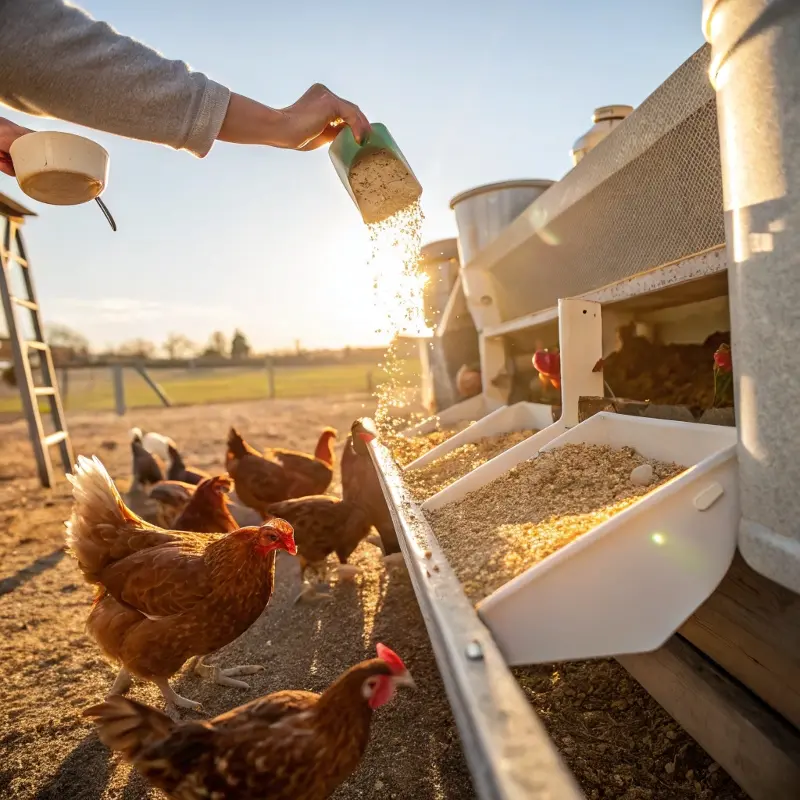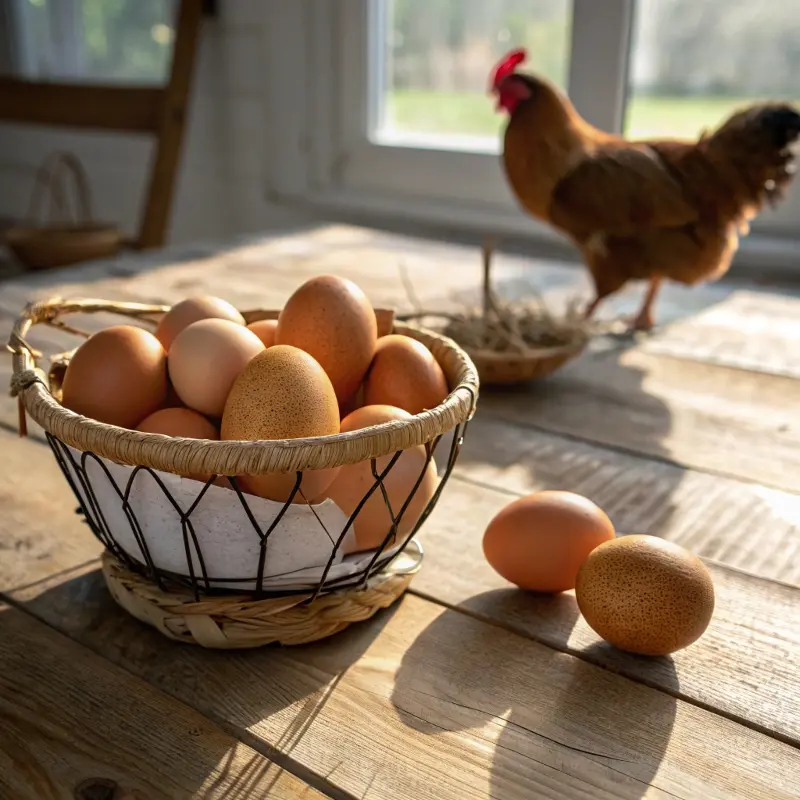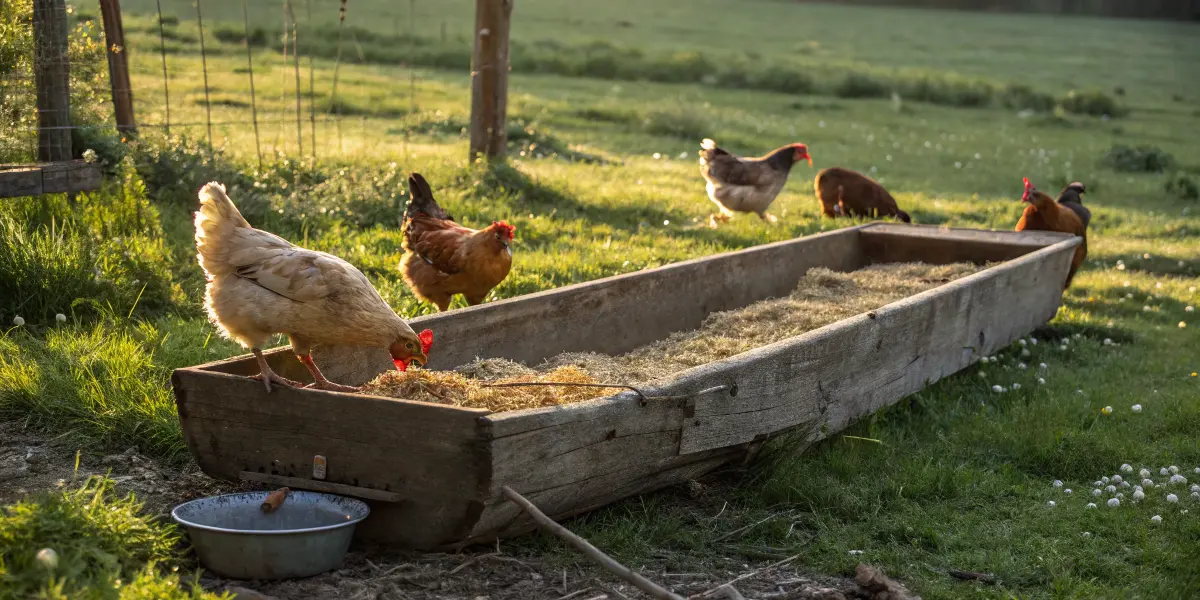When you’re raising chickens, it all starts with what you put in their feeder—and nothing is more important than protein. Whether you’re caring for layers or broilers, the right protein level can mean the difference between sluggish birds and a thriving, productive flock. In this guide, we’re diving into the essentials of high protein chicken feed: which types offer the most, how much your flock really needs, and what traditional approaches like the Amish diet look like. We’ll also clear up common questions—like whether 20% protein is too much—starting with why protein is the foundation of poultry health.
Print
High Protein Chicken Feed: Best Types, Nutrition & When to Use It
Homemade high-protein chicken feed ideal for layers, broilers, and molting hens. Easy to mix at home with nutrient-rich ingredients.
- Total Time: 5 minutes
- Yield: Makes 8 cups
Ingredients
4 cups cracked corn
2 cups soybeans (roasted or meal)
1 cup black soldier fly larvae (dried)
1 cup oats
1 cup sunflower seeds
1 tbsp kelp powder
1 tbsp poultry mineral mix
Instructions
1. Combine all dry ingredients in a large container.
2. Stir until well mixed.
3. Store in an airtight container away from moisture.
4. Feed 1/3 to 1/2 cup per bird daily depending on size and age.
5. Supplement with oyster shell if feeding to layers.
Notes
Adjust portions seasonally—add more BSFL during molting.
This mix reaches approximately 20–24% protein.
Ensure clean water is always available.
- Prep Time: 5 minutes
- Cook Time: 0 minutes
- Category: Homestead Feed
- Method: No-cook
- Cuisine: Poultry Nutrition
Table of Contents
Understanding High Protein Chicken Feed
Why Protein Is Vital for Poultry
Back in Santa Barbara, I used to feed our backyard chickens each morning with a mix of grains and dried herbs—unaware that I was fueling far more than their appetites. Protein was quietly doing the heavy lifting: building feathers, fueling egg production, maintaining immune strength, and keeping those hens lively. Without enough, egg output dips, feathers dull, and health declines. With the right level, birds stay vigorous.
The protein listed on feed bags is “crude protein,” measuring the total protein content from ingredients like soy, cornmeal, or fish meal. Adult layers typically need 16–18% protein. But during peak laying, molting, or winter stress, that number can climb safely to 20% or more. Chicks and meat birds? They may thrive on 24–30% for early growth.
Typical Protein Levels by Life Stage
Each stage of a chicken’s development demands a different protein ratio:
- Starter feed (0–6 weeks): 18–24%, sometimes up to 30% for game birds.
- Grower feed (6–20 weeks): Typically 16–20%, ideal for pullets developing muscle and bone.
- Layer feed (20+ weeks): 16–18% suits most, but 20% is great during peak production or seasonal molting.
- Broiler feed: 20–24% to promote efficient weight gain and muscle density.

Feeding should shift as your flock matures. Think of it like rotating recipes for seasonal health. Just like we balance flavor and nutrition in our slow cooker chicken pot pie soup, adjusting your birds’ diet keeps everything running smoothly. And when you collect those golden yolks, use them in these high protein egg bites for a delicious protein boost of your own.
Comparing High Protein Chicken Feed
Starter and Grower Feeds with 24–30% Protein
When chicks begin life, protein is essential for healthy bones, strong feathers, and steady growth. Starter feeds often contain 22–24% protein, and some game-bird blends go up to 30%. A trusted option is Nutrena’s NatureWise Meatbird Crumbles delivering 22% protein along with essential oils, prebiotics, and probiotics to support nutrient absorption and healthy digestion. While it’s not the highest percentage available, it’s a reliable, all-natural feed widely available online and in farm supply stores.
For those aiming for very high protein, certain specialty blends reach 28–30%—but use those only for short-term growth phases or rehabbing birds. These are best paired with clean water and no scratch grains until birds are a bit older to preserve nutrient balance.
High Protein Options for Layers
Once hens begin to lay, protein needs shift—but they don’t vanish. Most layer feeds hover around 16%, but many brands now offer enhanced versions. Purina’s Layena High Protein, for instance, bumps up to about 20%, helping hens maintain steady egg output even during stressful times like summer heat or molting.
Kalmbach’s Henhouse Reserve is another solid option. Though technically lower in protein (about 17%), it’s crafted with wholesome ingredients and designed for easy digestion, which improves absorption. This blend works well if you’re combining pellet feed with free-range foraging.

We’ve seen it firsthand: hens on a balanced, protein-rich diet lay longer and stronger. If your kitchen relies on reliable egg yield for recipes like our easy chicken pot pie meal prep or weekend air fryer egg bites, investing in higher-quality layer feed pays off.
FAQs About Chicken Protein Needs
What Chicken Food Has the Highest Protein?
The absolute highest-protein feeds available are usually labeled as game bird or turkey starter formulas. These feeds can reach up to 30%, like the Purina Game Bird Starter or Leland Mills’ 30% starter/grower mix. They’re specifically crafted for rapid growth, muscle development, and energy. Beyond commercial options, black soldier fly larvae (BSFL) offer a natural supplement with an astounding 40–45% protein content. While not a complete diet, they’re ideal for boosting protein in a free-range system.
Some flock owners also turn to alternative protein sources like scrambled eggs, cooked fish, or even finely crushed dry cat food (in limited quantities) during molting season. However, commercial high-protein blends remain the most consistent and safest choice.
Can You Feed 30% Protein to Chickens?
Yes—but with purpose and caution. Feeds with 30% protein are excellent for specific stages: chicks under six weeks, fast-growing meat breeds like Cornish Cross, or birds recovering from stress, illness, or molt. However, extended use on mature layers can lead to metabolic imbalances, especially if calcium and other nutrients aren’t adjusted accordingly.
Some experienced poultry keepers do cycle in higher-protein rations during peak laying or cold snaps. The key is moderation and duration. Feeding 30% protein continuously to laying hens might lead to thin eggshells, excess ammonia in droppings, or kidney strain. Always monitor your flock’s response closely.
Is 20% Protein Too High for Chickens?
Not at all. In fact, many layer blends intentionally reach 18–20%, especially those labeled as “high-performance” or “molt support.” This level gives hens the nutrients they need without overwhelming their systems. During the molt, when birds rebuild feathers, a 20% ration can make a noticeable difference in how quickly they recover.
Some backyard keepers also add protein-rich treats like mealworms or sunflower seeds in moderation. It’s a practice we often followed when prepping our flock for the colder months—right before making comfort dishes like this chicken stew in the crock pot, which turns those nourishing eggs and meat into family favorites.

What Do the Amish Feed Their Chickens?
Amish communities typically rely on whole-food ingredients. Their chicken feed often includes ground corn, oats, barley, and sometimes fish meal or roasted soybeans—all non-GMO. In many regions, they supplement with locally milled grains or even kitchen scraps, producing a high-protein, nutrient-dense feed without synthetic additives.
It’s not uncommon to find small Amish farms using a mix that mirrors popular natural brands like Scratch and Peck—grain-based, layered with minerals, and sometimes fermented for digestibility. Chickens raised this way often free-range during the day, which means they naturally consume protein-rich insects and greenery, similar to how birds peck through garden scraps near our kitchen window in Santa Barbara—often just as we prepped a chicken pot pie in the slow cooker.
When and How to Use High-Protein Feed Effectively
Life Stages and Conditions That Require Extra Protein
Just like we shift our diets during growth spurts, colder months, or recovery periods, chickens benefit from targeted nutrition too. High-protein feed isn’t just for chicks—it’s also essential during molt, peak laying, or periods of stress. For example, during fall molts, hens need amino acids to regrow feathers quickly and comfortably. This is the perfect time to bump their feed from 16% to 20% protein.
In colder climates, birds burn more energy staying warm. I remember my father always kept our hens’ feed richer in protein through December, which helped them stay active and maintain egg production even during short, dark days. Broilers, especially Cornish Cross, need constant high protein (20–24%) throughout their short lifespan to gain healthy weight.
New layers also benefit from added protein as they ramp up egg output. Offering them a transitional grower-layer blend with 18–20% protein and some extra calcium helps prevent thin shells and fatigue.
How to Balance High-Protein Diets Safely
While protein supports many functions, it can’t work alone. You need to balance it with calcium for shell strength and phosphorus for energy metabolism. That’s why many flock owners offer free-choice oyster shell or a mineral supplement alongside feed. Probiotics and prebiotics can also help birds digest their food more efficiently—especially in high-density flocks or during seasonal shifts.
Avoid relying on protein-only treats like mealworms or fish scraps as your birds’ main diet. They’re great supplements but can cause imbalances if not portioned correctly. Mix in whole grains, greens, and the occasional fermented mash for gut health.
Your birds’ output reflects their input. When they’re nourished correctly, they lay better and grow healthier—which you’ll notice in every farm-fresh egg and every dish, like our creamy chicken pot pie crockpot version, where quality protein starts in the coop.
FAQs About High Protein Chicken Feed
What chicken food has the highest protein?
Game bird starter feeds typically top the charts, offering up to 30% protein. These blends are designed for fast-growing poultry like turkeys or pheasants. For supplemental options, dried black soldier fly larvae provide over 40% protein and are a favorite treat for backyard flocks.
Can you feed 30% protein to chickens?
Yes, but only in the right context. Chicks, broilers, and game birds thrive on 30% protein during their early development. However, layers or mature hens shouldn’t stay on such high levels long-term, as it may lead to kidney strain or shell issues. Use high-protein feeds during specific needs like molting or cold stress, then return to balanced rations.
Is 20% protein too high for chickens?
Not at all. Most layer rations range from 16% to 18%, but 20% is safe and even beneficial during egg-laying peaks, recovery periods, or molt. Many commercial feeds like Purina Layena or transitional blends fall within this range and support long-term flock health.
What do the Amish feed their chickens?
Amish poultry diets are often built on non-GMO whole grains like oats, corn, and barley. They may include fish meal or soybean meal for added protein, and many flocks supplement naturally through foraging. This traditional approach resembles premium organic brands, emphasizing clean, nutritious feed without synthetic additives.
Conclusion
Feeding your chickens a high-protein diet doesn’t mean overloading their feed—it means giving them exactly what they need, when they need it. Whether you’re raising chicks, supporting hens through a tough molt, or trying to maintain egg output through the winter, protein plays a vital role in flock health and productivity. The key is balance: pair high protein levels with the right nutrients, use seasonal strategies, and pay attention to your birds’ behavior and output. With the right feed, you’ll see stronger shells, brighter feathers, and happier hens—and enjoy the benefits at your own table in every delicious, nutrient-rich meal.

